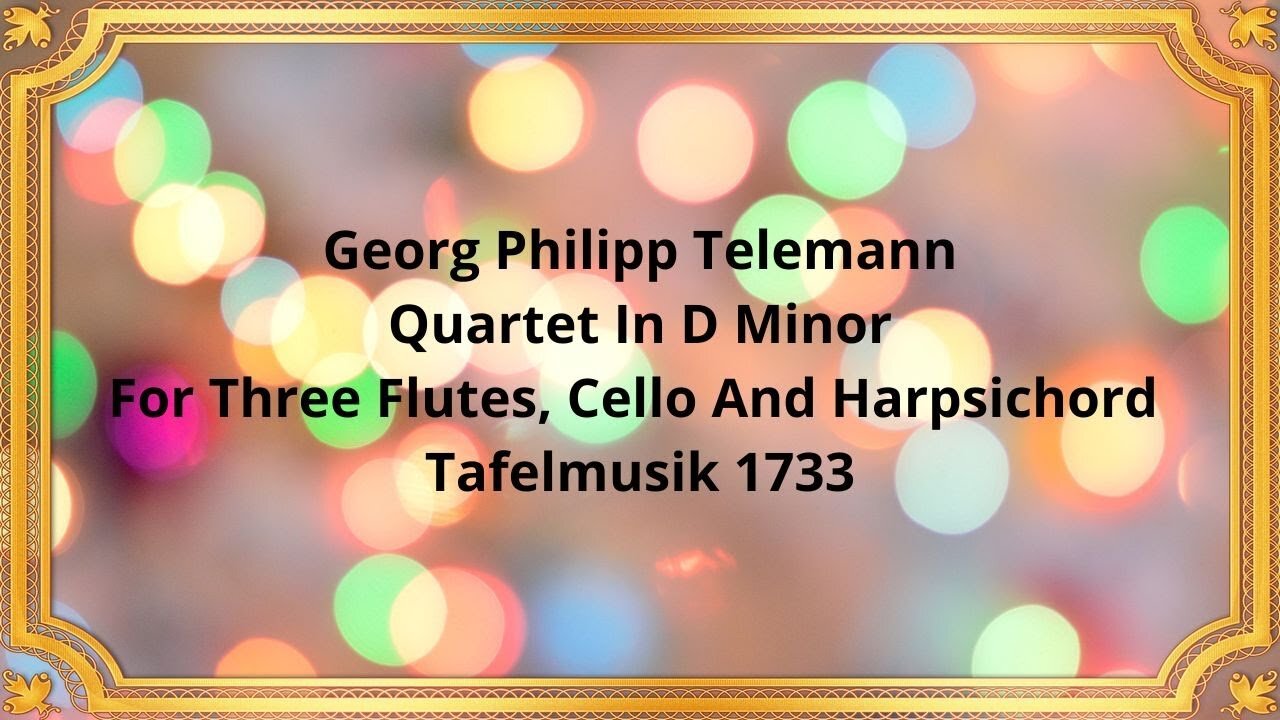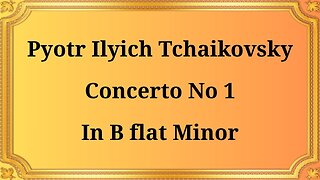Premium Only Content

Georg Philipp Telemann Quartet In D Minor For Three Flutes, Cello And Harpsichord Tafelmusik 1733,
#classicalmusic #GeorgPhilippTelemann #QuartetinDminor #flutes #cello #harpsichord #Tafelmusik #baroquemusic #composer #chambermusic #musicappreciation #musictheory #classicalconcerts #musichistory #baroqueera #musicperformance #classicalinstruments #musicalensemble
Publication date 1951
MILTON WITTGENSTEIN, Flute -
THOMAS WILT, Flute
SAMUEL BARON, Flute
MARCEL HUBERT, Violoncello
SYLVIA MARLOWE, Harpsichord
The rich tapestry of Baroque music is adorned with numerous masterpieces that have stood the test of time. Among these treasures is Georg Philipp Telemann's Quartet in D Minor for Three Flutes, Cello, and Harpsichord Tafelmusik 1733.
Composed in 1733, Telemann's Quartet in D Minor is a testament to the composer's remarkable talent and innovation. This piece is part of Telemann's renowned collection, Tafelmusik, a series of instrumental works designed to accompany social gatherings, banquets, and other festive occasions. The quartet showcases Telemann's ability to blend melodic beauty with intricate harmonies, creating a captivating musical experience.
The Quartet in D Minor for Three Flutes, Cello, and Harpsichord is a prime example of Telemann's mastery of chamber music. The composition is structured into several movements, each contributing to the overall thematic development and showcasing Telemann's skillful composition.
The quartet begins with a lively Allegro movement, characterized by its intricate interplay between the three flutes, cello, and harpsichord. Telemann's use of contrapuntal lines and rhythmic variation creates a sense of energy and excitement, captivating the listener from the very first notes.
Following the exuberance of the Allegro, the quartet transitions into the more introspective Grave movement. Telemann's expressive melodies, accompanied by the delicate sounds of the harpsichord, evoke a sense of melancholy and contemplation, adding depth and emotional contrast to the composition.
The quartet then picks up the pace with the Vivace movement, a lively and spirited section that showcases Telemann's gift for crafting memorable melodies. The interplay between the three flutes, accompanied by the rhythmic foundation of the cello and the intricate ornamentation of the harpsichord, creates a vibrant and engaging musical dialogue.
The quartet concludes with the Allegro assai movement, a dazzling display of virtuosity. Telemann's use of rapid passages, embellishments, and lively rhythms showcases the technical prowess of the performers, leaving the audience in awe of the ensemble's skill and musicianship.
Georg Philipp Telemann's Quartet in D Minor is significant in the realm of chamber music for several reasons. Firstly, it exemplifies Telemann's ability to create compositions that seamlessly integrate multiple instruments, showcasing his mastery of counterpoint and ensemble writing. Secondly, this quartet demonstrates Telemann's innovative approach to composition, blending elements of the Baroque style with his unique musical voice. Lastly, the Quartet in D Minor stands as a testament to Telemann's enduring influence on chamber music, inspiring future generations of composers to explore the possibilities of the genre.
Conclusion:
Georg Philipp Telemann's Quartet in D Minor for Three Flutes, Cello, and Harpsichord Tafelmusik 1733 is a shining example of the composer's artistry and innovation. Through its intricate melodies, harmonies, and interplay between instruments, this quartet captivates audiences with its beauty and technical brilliance. Telemann's contribution to the realm of chamber music is undeniable, and his quartet continues to be celebrated and performed to this day, ensuring that his legacy as a master of the Baroque era lives on.
You have the opportunity to support the channel:
https://destream.net/live/RadSiarAl/donate
https://www.buymeacoffee.com/6355radsiaral
-
 31:06
31:06
Classical music_Music Inspiration
18 days agoPyotr Ilyich Tchaikovsky Piano Concerto No. 1 in B-flat minor
511 -
 16:43
16:43
GritsGG
14 hours agoThey Buffed This AR & It Slaps! Warzone Loadout!
6.95K -
 2:05:30
2:05:30
Side Scrollers Podcast
18 hours agoEveryone Hates MrBeast + FBI Spends $140k on Pokemon + All Todays News | Side Scrollers Live
101K9 -
 11:06
11:06
The Pascal Show
12 hours ago $1.06 earned'THEY'RE GETTING DEATH THREATS!' Jake Haro's Lawyer Breaks Silence On Emmanuel Haro's Disappearance!
8.89K -
 LIVE
LIVE
Lofi Girl
2 years agoSynthwave Radio 🌌 - beats to chill/game to
412 watching -
 2:19:32
2:19:32
Badlands Media
1 day agoDEFCON ZERO Ep. 005: False Flags, Cyber Fronts & Global Power Plays
140K58 -
 2:35:23
2:35:23
FreshandFit
7 hours agoWhy Black Men Don't Date Black Women Debate
38.6K35 -
 2:03:42
2:03:42
Inverted World Live
11 hours agoBigfoot Corpse Coming to the NY State Fair | Ep. 94
108K25 -
 6:16:23
6:16:23
SpartakusLIVE
12 hours ago$1,000 Pistol Challenge || #1 ENTERTAINER of The EONS Eradicates BOREDOM
85.1K2 -
 2:33:37
2:33:37
TimcastIRL
9 hours agoTrump Orders Review of Smithsonian For Being Woke & Out of Control | Timcast IRL
188K78